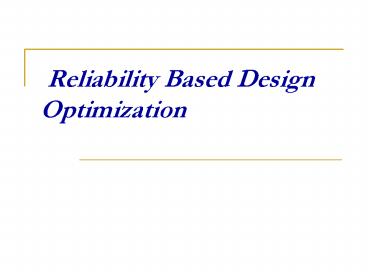Reliability Based Design Optimization - PowerPoint PPT Presentation
Title:
Reliability Based Design Optimization
Description:
Reliability Based Design Optimization – PowerPoint PPT presentation
Number of Views:818
Avg rating:3.0/5.0
Title: Reliability Based Design Optimization
1
Reliability Based Design Optimization
2
Outline
- RBDO problem definition
- Reliability Calculation
- Transformation from X-space to u-space
- RBDO Formulations
- Methods for solving inner loop (RIA , PMA)
- Methods of MPP estimation
3
Terminologies
- X vector of uncertain variables
- ? vector of certain variables
- T vector of distribution parameters of
uncertain variable X( means , s.d.) - d consists of ? and ? whose values can be
changed - p consists of ? and ? whose values can not be
changed
4
Terminologies(contd..)
- Soft constraint depends upon ? only.
- Hard constraint depends upon both X(?) and ?
- ?,? d,p
- Reliability 1 probability of failure
5
RBDO problem
- Optimization problem
- min F (X,?) objective
- fi (?) gt 0
- gj (X, ? ) gt 0
- RBDO formulation
- min F (d,p) objective
- fi (d,p) gt 0 soft constraints
- P (gj (d,p ) gt 0) gt Pt hard constraints
6
Comparison b/w RBDO and Deterministic Optimization
Feasible Region
Reliability Based Optimum
Deterministic Optimum
7
Basic reliability problem
8
(No Transcript)
9
Reliabilty Calculation
Probability of failure
10
Reliability Index
Reliability index
11
Formulation of structural reliability problem
Vector of basic random variables
represents basic uncertain quantities that define
the state of the structure, e.g., loads, material
property constants, member sizes.
Limit state function
Safe domain
Failure domain
Limit state surface
12
Geometrical interpretation
uS
Transformation to the standard normal space
failure domain
D f
limit state surface
safe domain
D S
uR
0
Cornell reliability index
Distance from the origin uR, uS to the linear
limit state surface
13
Hasofer-Lind reliability index
- Lack of invariance, characteristic for the
Cornell reliability index, can be resolved by
expanding the Taylor series around a point on
the limit state surface. Since alternative
formulation of the limit state function
correspond to the same surface, the
linearization remains invariant of the
formulation. - The point chosen for the linearization is one
which has the minimum distance from the origin
in the space of transformed standard random
variables . The point is known as the
design point or most probable point since it has
the highest likelihood among all points in the
failure domain.
14
Geometrical interpretation
For the linear limit state function, the absolute
value of the reliability index, defined as
, is equal to the distance from the origin of
the space (standard normal space) to the
limit state surface.
15
Hasofer-Lind reliability index
16
RBDO formulations
17
Double loop Method
Objective function
Reliability Evaluation For 1st constraint
Reliability Evaluation For mth constraint
18
Decoupled method(SORA)
Deterministic optimization loop Objective
function min F(d,µx) Subject to f(d,µx) lt
0 g(d,p,µx-si,) lt 0
k k1 si µxk xkmpp xkmpp ,pmpp
dk,µxk
Inverse reliability analysis for Each limit state
19
Single Loop Method
- Lower level loop does not exist.
- min F(µx)
- fi (µx) 0 deterministic constraintsgi (x) 0
- where
- x- µx -ßtas
- agrad(gu(d,x))/grad(gu(d,x))
- µxl µx µxu
20
Inner Level Optimization(Checking Reliability
Constraints)
- Performance Measure Approach(PMA)
- min gi ( u,µx )
- subject to u ßt
- If g(u, µx )gt0(feasible)
- Reliability Index Approach(RIA)
- min u
- subject to gi(u,µx)0
- if min u gtßt(feasible)
21
Most Probable Point(MPP)
- The probability of failure is maximum
corresponding to the mpp. - For the PMA approach , -grad(g) at mpp is
parallel to the vector from the origin to that
point. - MPP lies on the ß-circle for PMA approach and on
the curve boundary in RIA approach. - Exact MPP calculation is an optimization problem.
- MPP esimation methods have been developed.
22
MPP estimation
active constraint
- inactive
- constraint
RIA MPP
PMA MPP
PMA MPP
RIA MPP
U Space
23
Methods for reliability computation
Numerical computation of the integral in
definition for large number of random variables
(n gt 5) is extremely difficult or even
impossible. In practice, for the probability of
failure assessment the following methods are
employed
- First Order Reliability Method (FORM)
- Second Order Reliability Method (SORM)
- Simulation methods Monte Carlo, Importance
Sampling
24
FORM First Order Reliability Method
25
SORM Second Order Reliability Method
26
Gradient Based Method for finding MPP
- find a -grad(uk)/grad(uk)
- uk1ßt a
- If uk1-uklte, stop
- uk1 is the mpp point
- else goto start
- If g(uk1)gtg(uk), then perform an arc search
which is a uni-directional optimization
27
Abdo-Rackwitz-Fiessler algorithm
find
subject to
Rackwitz-Fiessler iteration formula
Gradient vector in the standard space
28
Abdo-Rackwitz-Fiessler algorithm
Convergence criterion
for every and
Very often to improve the effectiveness of the
RF algorithmthe line search procedure is employed
where is a constant lt 1, is
the other indication of the point
in the RF formula.
Merit function proposed by Abdo
29
Alternate Problem Model
- solution to
- min f s.t
- atleast 1 of the reliability constraint is
exactly tangent to the beta circle and all others
are satisfied. - Assumptions
- minimum of f occurs at the aforesaid point
30
Alternate Problem Model
x1
ß1
Reliability based optimum
ß2
x2
31
Scope for Future Research
- Developing computationally inexpensive models to
solve RBDO problem - The methods developed thus far are not
sufficiently accurate - Including robustness along with reliability
- Developing exact methods to calculate probability
of failure































